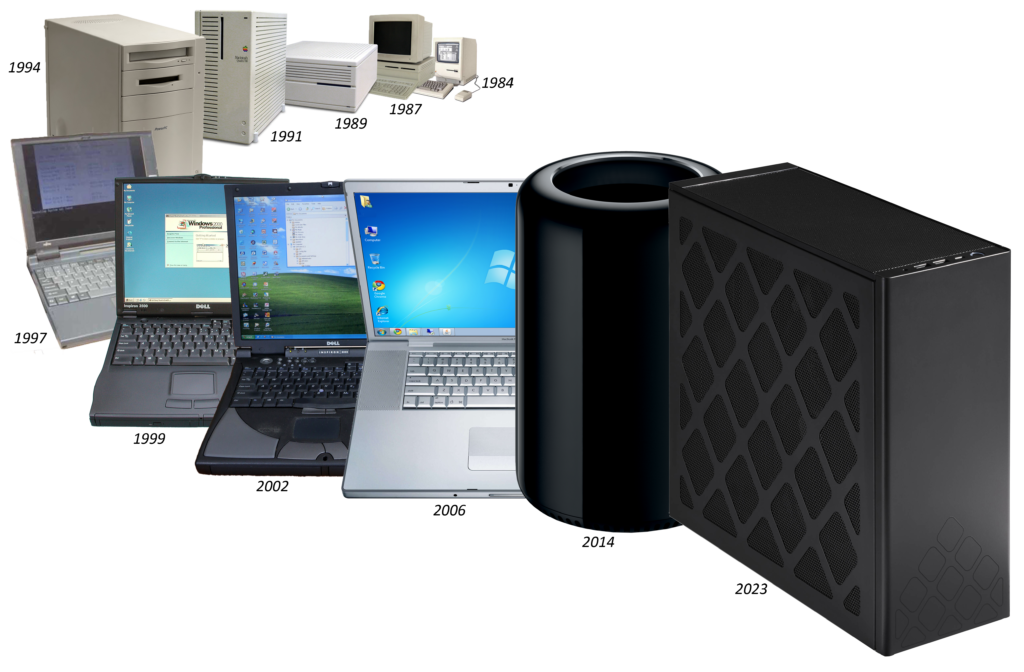Product & Book reviews
Pages…
Categories
- 3D (6)
- Electronics (2)
- Fire (3)
- Miscellaneous (3)
- Reviews (7)
- Book reviews (3)
- Software (2)
Product & Book reviews

Forty years ago, Moore’s Law was on a tear when it came to personal computing. Every year or two, CPU clock speeds doubled, RAM prices fell by half, and the compute power your OS and applications expected increased accordingly. You really had to buy a new machine every 2-3 years, or else your computer was hopelessly slow and out of date.
This slowed down by the late 2000s. The CPU chips had made the jump from 32 to 64 bits wide, and the clock speeds the processing chips ran at leveled off at around 3 – 4GHz or so. You could comfortably use the same computer for several years before replacing it. This is why the PC sales rate is a fraction of what it was 20 years ago.
My approach for buying my previous two computers was to get a top-end Macintosh and run Windows on it (I’ll explain the OS choice later). The fit, finish and performance of Apple hardware was excellent, and the selection process was very straightforward. When he returned to Apple, Steve Jobs paired the Mac product line down to simple groupings of computers making it easy to choose the right one. The rate of obsolescence had slowed down to almost a decade between replacements (though I may procrastinate on this longer than most). Read on for some history and how I selected a new machine…
read moreEven if “history is written by the victors”, that doesn’t mean the losers don’t have interesting stories to tell. Delete – a Design History of Computer Vaporware is the story of various computer systems that either never saw the light of day, or saw relatively little of it. This is one of the most unique computer history books I’ve run across.
The book introduces the concept of vaporware – systems promised but never delivered. It starts off with the grandfather of all computer vaporware, Babbage’s difference engine. Conceived in the early 1800s as a way to accurately print mathematical tables, Babbage kept tweaking and improving the design, instead of finishing it. The device became a moving engineering target that was never hit, with only a small section actually fabricated in his lifetime. Undaunted, Babbage went on to conceive the Analytical Engine, a full programmable computer made of shafts and gears. It was never fabricated.
From there the book moves on to the evolution of computers post WWII. The book covers the developments in Europe, in particular several early computer projects in Scandinavia I’d never heard of before. As the early mainframes transitioned to minicomputers in the 60s and 70s, the book covers machines like Honeywell’s “kitchen computer”. Featured in the 1969 Neiman-Marcus Christmas catalog as an absurd home accessory, the vaporware product nevertheless generated a welcome shot of publicity for both Honeywell and the retailer.

Some of Atkinson’s best revelations surround the development of the personal computer in the 1970s and ‘80s. In the 70s, IBM created a bright yellow plastic PC prototype called the “Yellow Bird” and another colorful red machine, the Aquarius. These were designed in response to the success of early computers by Apple and Atari. They were much more charming than the bland white IBM PC of 1981, and featured (then) exotic technologies such as bubble memory for mass storage. Alas, neither made it out of IBM’s labs.
The book reviews the influence of Xerox PARC’s research in the 1970s. Their creation of the Alto prototype with bitmapped displays displaying overlapping windows is well known. Atkinson, however, also reveals the “Notetaker”, another Alan Kay design for a luggable computer with a keyboard fastening over the display screen on the top. This design was successfully commercialized by other companies, including Osborn, Kaypro and Compaq. From there, the book moves through PCs to pen computing in the 1990s, the precursor to today’s touchscreen phones and tablets.
Atkinson’s primary focus for much of the book is industrial design; what the devices looked and felt like. Often, the work of the same designer reverberated across multiple product concepts, even if it only rarely made it to store shelves. The book is beautifully illustrated, filled color photographs of ingenious computer designs. I did find a few minor quibbles with his history (Berkeley Unix fans won’t appreciate Sun co-founder William Joy described as a “fellow Stanford graduate”), but on the whole, he sheds welcome light on a fascinating swath of the history of computer design.
Published in 2013, Delete isn’t a new book. However, the evolution of physical computer design seems to have plateaued since then anyway. Phones – everybody’s primary computer these days – have devolved into featureless glass slabs. And one of my favorite computer designs, the Macbook Air, is over a decade old now. The vaporware covered in Delete had significant influence on today’s computer products, even if they never made it to the store shelves themselves.
I started working with computers when they were much less reliable than they are now. Old operating and file systems frequently lost or corrupted your data, teaching you the importance of a backup copy. Then the fire at our house reinforced the importance of offsite backups. The $50-150 a year cost is cheap insurance against losing all your creative work, financial and (ahem) insurance records.
A few months after the fire I set up our computers with CrashPlan. We used it at work, and it worked very well at home. But this summer CrashPlan announced they were pulling the plug on home usage, and their commercial offerings weren’t very economic for few home PCs.
CrashPlan gave plenty of warning their home service is discontinued, but watching smoke roll in to Silicon Valley from the 2017 North Bay fires was a grim reminder. To my surprise, it took a few tries to get find a reliable replacement. Here’s my experience.
The Neptune File: A Story of Astronomical Rivalry and the Pioneers of Planet Hunting
You might expect planet Neptune’s discovery to be worthy of a footnote, or a magazine article at most. Yet Tom Standage manages to bring alive a fascinating story with an entertaining cast of characters from the 19th century around this discovery.
Man has known about the first six planets since ancient times. They’re bright enough to be seen with the naked eye, and their movements across the sky clearly distinguish them from the stars.
Searching the sky with his advanced (for the time) telescope, amateur astronomer William Hershel discovers a seventh planet, Uranus, in 1781. This created a sensation among astronomers, and opened up the possibility of more planets in the sky.
While trying to compute the precise orbit of Uranus, astronomers noted something wasn’t quite right. It was speeding up and slowing down from where it was expected to be. Two astronomers, the brash Frenchman Urbain Le Verrier and the quiet Englishman John Adams begin undertaking the complex calculations to try and predict where the new planet should appear.
With the calculations underway, the race is on to actually find the new planet, an amazing achievement with 19th century technology. The acrimony and infighting resulting from the discovery also makes for a great story.

One of my more prized positions is was a Chumby prototype, right off the desk of it’s hardware designer. I won it in one of the designer’s monthly Name That Ware contests. The idea behind the Chumby was to have a box on your desk or nightstand running casual applications to tell the time, weather, photos, or other entertaining data. A back-end service made it easy to download new apps, which were written in Flash (this was in the late 2000’s, Flash was still a thing then). It was beautifully designed, featuring graphics by Susan Kare and a classy soft leather case.
But Chumby, Inc. died. A combination of bad timing (missing Christmas in 2007, followed by the global economic meltdown in 2008) and the introduction of the iPhone – the gadget to end all gadgets – made it tough for Chumby to find a market. Kudos to Duane Maxwell for keeping the remaining Chumbys on life support.
Recently Tingbot introduced a Raspberry Pi based computer with a small LCD display in a nice desktop case. It immediately reminded me of the Chumby.
What would happen to a major metropolitan area – say, NY or LA – if the electric power grid completely failed, for multiple weeks at a time? The result isn’t pretty, and this is the topic long-time TV journalist Ted Koppel covers in Lights Out. The book claims the electric power grid is subject to a uniquely new threat: Attack by cyber criminals who can disable huge portions of electric power supply remotely. read more

This post originally appeared on Medium.com.
I like scanners. See, at one time I was really into books. But after a decade or two, you come to the conclusion books take physical space. Lots of it. So when my tax guy showed me his Fujitsu ScanSnap I was hooked. Mine ingested most loose papers, statements and documents. This cleared a shelf or two. I also scanned many books by sawing their spines off, and feeding them to the ScanSnap fifty pages or so at a time. It works great, and this cleared several more feet of shelf space.
However, there are some books I just can’t bear to saw up to feed to a sheet-feed scanner, and this is the niche the Czurtek ET16 falls into. I also had fantasies of using it to replace my slow, clumsy flatbed scanner. So, I signed up to the Indiegogo campaign, for $234.